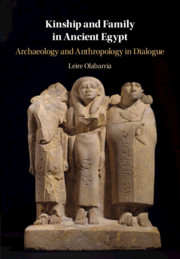Book contents
- Kinship and Family in Ancient Egypt
- Kinship and Family in Ancient Egypt
- Copyright page
- Dedication
- Contents
- Figures
- Acknowledgements
- Map of Egypt
- Part I Ancient Egyptian Kinship in Context
- Part II On Koinographic Analysis
- Six The Birth of a Kin Group
- Seven The Summit of a Developmental Cycle
- Eight Displaying Decline
- Nine Conclusions
- Appendix: ANOC Table
- Notes
- Bibliography
- Index
Nine - Conclusions
The Dynamism of the Social Fabric
from Part II - On Koinographic Analysis
Published online by Cambridge University Press: 26 February 2020
- Kinship and Family in Ancient Egypt
- Kinship and Family in Ancient Egypt
- Copyright page
- Dedication
- Contents
- Figures
- Acknowledgements
- Map of Egypt
- Part I Ancient Egyptian Kinship in Context
- Part II On Koinographic Analysis
- Six The Birth of a Kin Group
- Seven The Summit of a Developmental Cycle
- Eight Displaying Decline
- Nine Conclusions
- Appendix: ANOC Table
- Notes
- Bibliography
- Index
Summary
Chapter 9 summarises the most important contributions of the book. Weaving together archaeological and anthropological approaches makes it possible to characterise forms of relatedness in ancient Egypt as a process, as a phenomenon based on practice.
The main methodology relies on group approaches to monuments and people. Stelae need to be integrated within clusters into so-called memorial chapels, and analysed as parts of a wider landscape. Those objects can be regarded as agents, having a clear impact on their audiences and affecting the perception and construction of social fabric.
As people should not be treated in isolation, this book focuses on kin groups instead of individual kin types. Kin group is seen as an etic grid that acquires emic content through careful analysis of the primary sources. Although six attributes of these groups are proposed, not all need to occur at the same time. Kin groups are then analysed through koinography, taking the kin group as the preferred unit of social analysis in a diachronic framework. Overall kinship is understood as a process that by being displayed in monuments contributes to creating and disseminating ideas about ancient Egyptian social fabric.
- Type
- Chapter
- Information
- Kinship and Family in Ancient EgyptArchaeology and Anthropology in Dialogue, pp. 189 - 204Publisher: Cambridge University PressPrint publication year: 2020



